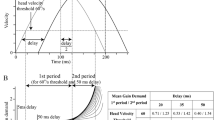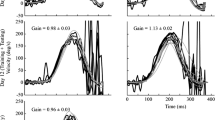Abstract
The pendulum model of the vestibulo-ocular reflex, including the effects of adaptation, has been evaluated using the responses of 36 normal subjects to impulsive stimuli of 128 and 256°/s. Estimates of the model parameters such as the time constants, the slow velocity threshold, and the minimum stimulus required to produce an after-nystagmus have been obtained using a new analytical technique. Although some of the data support the validity of the adaptation model, evidence is presented to demonstrate that the overall applicability of the model is limited.
Similar content being viewed by others
References
Aschan, G.: The mechanism of the cupula ampullaris in man. Acta Soc. Medicorum Upsaliensis 60, 77–88 (1955, 1956)
Aschan, G., Nylen, C.O., Stahle, J., Wersall, R.: The rotation test Cupulometric data from 320 normals. Acta Otolaryngol. (Stockh.) 42, 451–459 (1952)
Baloh, R. W., Sills, A. W., Honrubia, V.: Impulsive and sinusoidal rotatory testing. A comparison with results of caloric testing Laryngoscope (in press)
Barr, C.C., Schultheis, L.W., robinson, D.A.: Voluntary, non-visual control of the human vestibulo-ocular reflex. Acta Otolaryngol. (Stockh.) 81, 365–375 (1976)
Dohlman, G.: On the mechanism of transformation into nystagmus on stimulation of the semicircular canals. Acta Otolaryngol. (Stockh.) 26, 425–442 (1938)
van Egmond, A.A.J., Groen, J.J., Jongkees, L.B.W.: The mechanics of the semicircular canal. J. Physiol. 110, 1–17 (1949)
van Egmond, A.A.J., Groen, J.J., Jongkees, L.B.W.: The function of the vestibular organ. Pract. ORL 14, Suppl. 2 (1952)
Fernandez, D., Goldberg, J.M.: Physiology of peripheral neurons innervating the semicircular canals of the squirrel monkey. II. The response to sinusoidal stimulation and the dynamics of the peripheral vestibular system. J. Neurophysiol. 34, 661–675 (1971)
Gilman, S., Dirks, D.D., Hunt, S.: Measurement of head movement during auditory localization (submitted for publication)
Gonshor, A., Melvill-Jones, G.: Short-term adaptive changes in the human vestibulo-ocular reflex arc. J. Physiol. (Lond.) 256, 361–379 (1976a)
Gonshor, A., Melvill-Jones, G.: Extreme vestibulo-ocular adaptation induced by prolonged optical reversal of vision. J. Physiol. (Lond.) 256, 381–414 (1976b)
Groen, J.J.: The semicircular canal system of the organs of equilibrium. II. Central inhibition. Phys. Med. Biol. 1, 225–242 (1956, 1957)
Groen, J.J.: Cupulometry. Laryngoscope 67, 894–905 (1957a)
Groen, J.J.: Adaptation. Pract. ORL 19, 524–530 (1957b)
Guedry, F.E.: Psychophysics of vestibular sensation. In: Handbook of sensory physiology. Vol. VI. Part 2. p. 40. Kornhuber, H.H., ed. Berlin, Heidelberg, New York: Springer 1974
Guedry, F.E., Stockwell, C.W., Norman, J.W., Owens, G.G.: Use of triangular waveforms of angular velocity in the study of vestibular function. Acta Otolaryngol. (Stockh.). 71, 439–448 (1971)
Hallpike, C.S., Hood, J.D.: The speed of the slow component of ocular nystagmus induced by angular acceleration of the head: Its experimental determination and application to the physical theory of the cupular mechanism. Proc. Roy. Soc. (Biol.) 141, 216–230 (1953)
Julius, R.S.: The sensitivity of exponentials and other curves to their parameters. Computers Biomed. Res. 5, 473–478 (1972)
Konrad, H.R., Sills, A.W., Baloh, R.W., Honrubia, V.: The impulsive test in man. Trans. AAOO 82, ORL-232-238 (1976)
Lorente de Nó, R.: Ausgewählte Kapitel aus der vergleichenden Physiologie des Labyrinths. Die Augenmuskelreflexe beim Kaninchen und ihre Grundlagen. Ergeb. Physiol. 32, 73–242 (1931)
Lowenstein, O., Sand, A.: The individual and integrated activity of the semicircular canals of the elasmobranch labyrinth. J. Physiol. (Lond.) 99, 89–101 (1940)
Malcolm, R.: Progress in vestibular modeling. Part III. A quantitative study of vestibular adaptation in humans. Fourth symposium on the role of the vestibular organs in space exploration. NASA SP-187, 369–380 (1968)
Malcolm, R., Melvill-Jones, G.: A quantitative study of vestibular adaptation in humans. Acta Otolaryngol. (Stockh.) 70, 126–135 (1970)
van Mastrigt, R.: Constant-step approximation of multi-exponential signals using a least-squares criterion. Comput. Biol. Med. 7, 231–247 (1977)
McClure, J.A., Lycett, P., Bicker, G.R.: A quantitative rotational test of vestibular function. J. Otolaryngol. 5, 279–288 (1976)
Meiry, J.L.: The vestibular system and human dynamic space
ientation. ScD thesis, MIT Department of Aeronautics and Astronautics, Man-Vehicle Laboratory (1965)
Melvill-Jones, G.: Transfer function of labyrinthine volleys through the vestibular nuclei. Prog. Brain Res. 37, 139–156 (1972)
Melvill-Jones, G., Barry, W., Kowalsky, N.: Dynamics of the semicircular canals compared in yaw, pitch, and roll. Aerospace Med. 35, 984–989 (1964)
Melvill-Jones, G., Milsum, J.H.: Characteristics of neural transmission from the semicircular canals to the vestibular nuclei of cats. J. Physiol. (Lond.) 209, 295–316 (1970)
Milsum, J.H.: Biological control systems analysis. New York: McGraw-Hill 1966
Oman, C.M., Young, L.R.: The physiological range of pressure difference and cupula deflections in the human semicircular canal. Theoretical considerations. Acta Otolaryngol. (Stockh.) 74, 324–331 (1972)
Parsons, R.D.: Magnitude estimates of the oculogyral illusion during and following angular acceleration. J. Exp. Psychol. 84, 230–238 (1970)
Ranacher, G.: Die Nystagmusdauer nach Drehbeschleunigung in Theorie und Experiment. Arch. ORL 214, 313–318 (1977)
Robinson, D.A.: Adaptive gain control of vestibuloocular reflex by the cerebellum. J. Neurophysiol. 39, 954–969 (1976)
Schmid, R.M.: Systems analysis of the vestibulo-ocular system. Fifth symposium on the role of the vestibular organs in space exploration. NASA SP-314, 237–249 (1970)
Schmid, R., Lardini, F.: On the predominance of anti-compensatory eye movements in vestibular nystagmus. Biol. Cybernetics 23, 135–148 (1976)
Schmid, R., Stefanelli, M., Mira, E.: Mathematical modeling. A contribution to clinical vestibular analysis. Acta Otolaryngol. (Stockh.) 72, 292–302 (1971a)
Schmid, R.M., Stefanelli, M.V., Anzaldi, E.G.: A mathematical model accounting for nonzero final value of the cumulative eye position in post-rotational nystagmus. Digist 9th Int. Conf. Med. Biol. Engineering, 37 (1971b)
Sills, A.W., Baloh, R.W., Honrubia, V.: Caloric testing. II. Results in normal subjects. Ann. ORL Suppl. 43 (1977)
Sills, A.W., Honrubia, V.: A new method for determining impulsive time constants and their application to clinical data. Otolaryngology 86, ORL 81-89 (1978)
Steer, R.W.: The influence of angular and linear acceleration and thermal stimulation on the human semicircular canal. ScD Thesis, MIT Department of Aeronautics and Astronautics, Man-Vehicle Laboratory (1967)
Steinhausen, W.: Über den Nachweis der Bewegung der Cupula in der intakten Bogengangsampulle des Labyrinths bei der natürlichen rotatorischen und calorischen Reizung. Pflügers Arch. ges. Physiol. 228, 322–328 (1931)
Steinhausen, W.: Über die Beobachtung der Cupula in den Bogengangsampullen des Labyrinths des lebenden Hechts. Pflügers Arch. ges. Physiol. 232, 500–512 (1933)
Stockwell, C.W., Gilson, R.D., Guedry, F.E.: Adaptation of horizontal semicircular canal responses. Acta Otolaryngol. (Stockh.) 75, 471–476 (1973)
Young, L.R.: A control model of the vestibular system. In: Technical and biological problems of control — A cybernetic view, p. 543. Iberall, A.S., Reswick, J.B. (eds.) Distributed by Instrument Soc. America (1968)
Young, L.R., Oman, C.M.: Model for vestibular adaptation to horizontal rotation. Aerospace Med. 40, 1076–1080 (1969)
Author information
Authors and Affiliations
Additional information
This work was supported by NIH Grant NS 09823
Rights and permissions
About this article
Cite this article
Sills, A.W., Honrubia, V. & Baloh, R.W. Is the adaptation model a valid description of the vestibulo-ocular reflex?. Biol. Cybernetics 30, 209–220 (1978). https://doi.org/10.1007/BF00361042
Received:
Issue Date:
DOI: https://doi.org/10.1007/BF00361042




